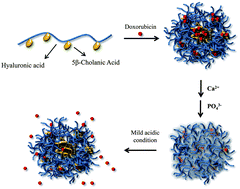Mineralized hyaluronic acidnanoparticles as a robust drug carrier
Abstract

* Corresponding authors
a
Departments of Advanced Polymer and Chemical Engineering, College of Engineering, Kyung Hee University, Gyeonggi-do, Republic of Korea
E-mail:
jaehyung@khu.ac.kr
Fax: +82-31-204-8114
Tel: +82-31-201-3256
b Department of Maxillofacial Biomedical Engineering & Institute of Oral Biology, School of Dentistry, Kyung Hee University, Seoul, Republic of Korea
c School of Medicine, Kyungpook National University, Daegu, Republic of Korea
d Department of Life and Nanopharmaceutical Sciences, Kyung Hee University, Seoul, Republic of Korea

 Please wait while we load your content...
Something went wrong. Try again?
Please wait while we load your content...
Something went wrong. Try again?
S. Han, H. S. Han, S. C. Lee, Y. M. Kang, I. Kim and J. H. Park, J. Mater. Chem., 2011, 21, 7996 DOI: 10.1039/C1JM10466G
To request permission to reproduce material from this article, please go to the Copyright Clearance Center request page.
If you are an author contributing to an RSC publication, you do not need to request permission provided correct acknowledgement is given.
If you are the author of this article, you do not need to request permission to reproduce figures and diagrams provided correct acknowledgement is given. If you want to reproduce the whole article in a third-party publication (excluding your thesis/dissertation for which permission is not required) please go to the Copyright Clearance Center request page.
Read more about how to correctly acknowledge RSC content.
 Fetching data from CrossRef.
Fetching data from CrossRef.
This may take some time to load.
Loading related content
